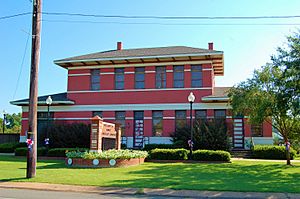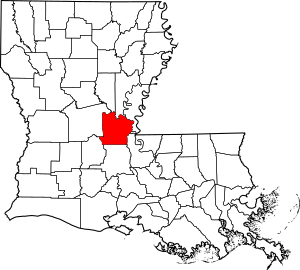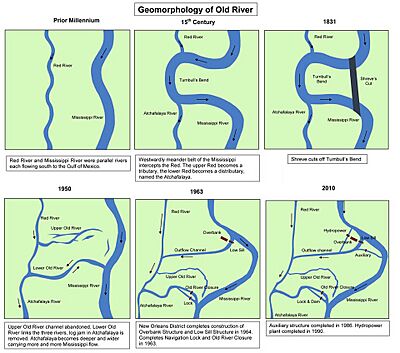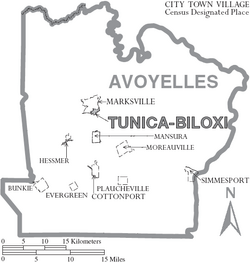Avoyelles Parish, Louisiana facts for kids
Quick facts for kids
Avoyelles Parish
|
||
|---|---|---|

Texas and Pacific Railroad Depot (Bunkie, Louisiana)
|
||
|
||

Location within the U.S. state of Louisiana
|
||
 Louisiana's location within the U.S. |
||
| Country | ||
| State | ||
| Founded | March 31, 1807 | |
| Named for | Avoyel Native Americans | |
| Seat | Marksville | |
| Largest city | Marksville | |
| Area | ||
| • Total | 866 sq mi (2,240 km2) | |
| • Land | 832 sq mi (2,150 km2) | |
| • Water | 33 sq mi (90 km2) 3.8% | |
| Population
(2020)
|
||
| • Total | 39,693 | |
| • Density | 45.835/sq mi (17.697/km2) | |
| Time zone | UTC−6 (Central) | |
| • Summer (DST) | UTC−5 (CDT) | |
| Congressional district | 5th | |
Avoyelles (French: Paroisse des Avoyelles) is a special type of county called a parish. It is located in central eastern Louisiana. You can find it where the Red River meets the Atchafalaya River and the Mississippi River.
In 2020, about 39,693 people lived here. The main town and parish seat is Marksville. The parish was created in 1807. Its name comes from the French name for the historic Avoyel people. They were one of the local Indian tribes when Europeans first arrived.
Today, the federally recognized Tunica-Biloxi Indian Tribe lives here. They have a special area called a reservation. This reservation includes parts of Marksville. The tribe also runs a casino on their land.
Contents
History
Native Americans lived in this area a very long time ago. Their cultures started to grow here around 300 BC. Over many centuries, different groups thrived.
In Marksville, you can still see three large burial mounds. These mounds were built by the Mississippian culture. This culture was strong between 900 AD and 1500 AD. They lived mostly along the Mississippi and Ohio Rivers. Their trading network reached from the Gulf Coast to the Great Lakes.
The Tunica people were one of the groups living in the central Mississippi Valley. They later joined with the smaller group of Avoyel people. Over time, they also mixed with the Biloxi people. In the 20th century, these groups officially formed the Tunica-Biloxi Indian Tribe. The U.S. government recognized them in 1981. They are the largest Native American tribe in Avoyelles Parish. Their reservation is partly in Marksville.
Avoyelles Parish is known for its French history. Many people here still use French words and traditions. The local Creole culture mixes European, African, and Native American influences. This can be seen in their music and food.
Avoyelles is the most northern of the 22 "Acadiana" parishes. These areas were settled by French-speaking refugees from Acadia. Acadia is now eastern Canada. These refugees arrived in the late 1700s. They, along with Africans and Native Americans, helped shape the culture here. The parish is famous for its Cajun/Creole music. It is also known for its delicious gumbo, a popular soup.
The middle part of Avoyelles Parish is on a plateau. This land is a bit higher than the surrounding floodplains. For a long time, traveling by water was the main way to get around. Native Americans used canoes. Early French settlers used their own boats called pirogues.
Old church records from Mansura and Marksville tell us about early French settlers. They built a trading post and a Catholic school. The traders wanted to trade furs with the Tunica Tribe. Missionaries hoped to teach the natives about Christianity. The trading post was near the Avoyel/Tunica village. It was saved until the mid-1960s. Roadside signs on LA 1 show where the old Catholic mission school was.
Early European settlers called this area Hydropolis. This means "water city." It referred to the many marshes and bayous. People traveled mostly by Indian canoe and pirogue. Church records listed families and their property. Sometimes, they even listed enslaved people by name.
At first, church records were written in French. Then, they were in Spanish when Spain ruled the area. After Napoleon Bonaparte took control, they went back to French.
In 1803, Napoleon sold the huge Louisiana Purchase territory to the United States. This happened after his army failed to control Saint-Domingue (now Haiti). The U.S. government then explored the new land. They hired French soldiers, surveyors, and doctors. Many of them later settled in Avoyelles.
Many French people came to Avoyelles Parish in the late 1700s and early 1800s. Some French words used in the parish today are from Napoleon's time. This shows when many people moved here. These words are no longer used in France.
Spanish influence was stronger in other parts of Louisiana, like New Iberia. There are no Spanish family names in Avoyelles. A few families from French Canada (Quebec) also settled here. They were different from the Acadians. The British forced Acadians out of their homeland in Canada starting in 1755. Many Acadians later came to Louisiana between 1764 and 1788.
Later in the 1800s, people from Scotland, Belgium, Italy, and Germany also settled here. They joined the French Creoles. Together, they built the towns and villages we see today. These new settlers had direct ties to Europe. This made them different from the Acadians (Cajuns) in southern Louisiana. Acadians had lived in Canada for many generations.
Around 1900, free people of color also settled in Avoyelles. Many came from New Orleans. Others were refugees from Saint-Domingue. There, enslaved people fought for their freedom and created the nation of Haiti. Some also came from other French West Indies islands.
The mixing of these three cultures—Native American, European, and African—created a unique Louisiana Creole culture. You can see this in the local language, food, Catholic religion, and family ties.
Today, Avoyelles Parish culture is often called "Cajun." This is because the speech, food, and traditions seem similar to the southern Acadian parishes. However, few families in Avoyelles are actually of Acadian descent. From the 1800s to the mid-1900s, local newspapers called Avoyelles French families "Creoles." This term meant people born in the colony who were direct descendants of early French settlers.
After the terrible Great Mississippi Flood of 1927, the U.S. Army Corps of Engineers built levees. These walls helped protect towns like Marksville from immediate flooding. But they also changed the wetlands. This has sometimes led to more serious flooding later on.
Geography
Avoyelles Parish covers about 866 square miles. Most of this (832 square miles) is land. About 33 square miles (3.8%) is water.
The parish's eastern side is bordered by the Red River and Atchafalaya River. The Atchafalaya River formed when the Mississippi River changed its path. In the 1900s, the Old River Control Structure was built here. It helps control how water flows between the three rivers.
Major highways
 Interstate 49
Interstate 49 U.S. Highway 71
U.S. Highway 71 Louisiana Highway 1
Louisiana Highway 1 Louisiana Highway 29
Louisiana Highway 29 Louisiana Highway 107
Louisiana Highway 107
Adjacent parishes
- La Salle Parish (north)
- Catahoula Parish (north)
- Concordia Parish (northeast)
- West Feliciana Parish (east)
- Pointe Coupee Parish (southeast)
- St. Landry Parish (south)
- Evangeline Parish (southwest)
- Rapides Parish (west)
National protected areas
- Grand Cote National Wildlife Refuge (part)
- Lake Ophelia National Wildlife Refuge
Demographics
| Historical population | |||
|---|---|---|---|
| Census | Pop. | %± | |
| 1810 | 1,209 | — | |
| 1820 | 2,245 | 85.7% | |
| 1830 | 3,484 | 55.2% | |
| 1840 | 6,616 | 89.9% | |
| 1850 | 9,326 | 41.0% | |
| 1860 | 13,167 | 41.2% | |
| 1870 | 12,926 | −1.8% | |
| 1880 | 16,747 | 29.6% | |
| 1890 | 25,112 | 49.9% | |
| 1900 | 29,701 | 18.3% | |
| 1910 | 34,102 | 14.8% | |
| 1920 | 35,300 | 3.5% | |
| 1930 | 34,926 | −1.1% | |
| 1940 | 39,256 | 12.4% | |
| 1950 | 38,031 | −3.1% | |
| 1960 | 37,606 | −1.1% | |
| 1970 | 37,751 | 0.4% | |
| 1980 | 41,393 | 9.6% | |
| 1990 | 39,159 | −5.4% | |
| 2000 | 41,481 | 5.9% | |
| 2010 | 42,073 | 1.4% | |
| 2020 | 39,693 | −5.7% | |
| U.S. Decennial Census 1790–1960 1900–1990 1990–2000 2010 |
|||
| Race | Number | Percentage |
|---|---|---|
| White (non-Hispanic) | 25,236 | 63.58% |
| Black or African American (non-Hispanic) | 10,649 | 26.83% |
| Native American | 349 | 0.88% |
| Asian | 345 | 0.87% |
| Pacific Islander | 3 | 0.01% |
| Other/Mixed | 1,626 | 4.1% |
| Hispanic or Latino | 1,485 | 3.74% |
In 2020, the census showed 39,693 people living in the parish. There were 15,163 households and 9,840 families. This was a slight decrease from 42,073 residents in 2010.
In 2000, the parish had 41,481 people. About 68.47% were White, and 29.49% were Black or African American. About 1.01% were Native American. In 2020, the racial makeup was 63.58% non-Hispanic white and 26.83% Black or African American.
In 2000, about 36.30% of households had children under 18. About 51.70% were married couples. The average household had 2.60 people. The average family had 3.11 people.
The median age in 2000 was 35 years. For every 100 females, there were 96.40 males. About 25.90% of the population lived below the poverty line. This included 32.50% of those under 18.
Education
The Avoyelles Parish School Board runs all public schools. It has 10 schools with over 6,000 students. You can find more information on their website: Avoyelles Parish School Board.
Elementary schools
- Cottonport Elementary
- Bunkie Elementary
- Lafargue Elementary
- Marksville Elementary
- Plaucheville Elementary
- Riverside Elementary
- Sacred Heart School, Moreauville
- St. Anthony of Padua School, Bunkie
- St. Joseph School, Plaucheville
- St. Mary of the Assumption School, Cottonport
High schools
- Avoyelles High School (Moreauville)
- Avoyelles Public Charter School
- Bunkie High School
- LASAS (Louisiana School for the Agricultural Sciences)
- Marksville High School
- Red River Charter Academy
- St. Joseph's High School of Plaucheville
National Guard
The 1020th Engineer Company is located in Marksville, Louisiana. The 1086th Transportation Company is in Bunkie, Louisiana. These are parts of the 225th Engineer Brigade.
Communities
Cities
- Bunkie
- Marksville (This is the main town and the largest.)
Towns
Villages
Unincorporated areas
Census-designated places
Other communities
Notable people
Artists, authors and entertainers:
- Sue Eakin: A historian and author. She wrote Avoyelles Parish: Crossroads of Louisiana.
- Alcide "Blind Uncle" Gaspard: An early musician who recorded traditional Cajun music.
- Little Walter: Marion Walter Jacobs was a famous musician and harmonica player. He is in the Rock and Roll Hall of Fame.
- Ruth McEnery Stuart: An author from Marksville.
- Solomon Northup: A free man from New York. He was kidnapped and forced into slavery for almost 12 years in Avoyelles Parish. He was freed in 1853. He wrote a best-selling book about his experiences called Twelve Years a Slave (1854). This book was made into a movie in 2013, which won many awards.
Athletes:
- Mark Duper: From Moreauville, he was a Miami Dolphins wide receiver in American football.
- Allen Barbre: An American football offensive tackle who played for the Denver Broncos.
Other:
- John Baptist Lafargue: An American educator, newspaper publisher, and editor.
- Felix Eugene Moncla Jr.: A United States Air Force pilot who disappeared over Lake Superior in 1953.
Political leaders:
- Bill Callegari: A former politician from Texas, born in Cottonport in 1941.
- Edwin Washington Edwards: He served four terms as the governor of Louisiana.
- Elaine Schwartzenburg Edwards: The first wife of Edwin Edwards. She was appointed as a U.S. Senator for a short time in 1972.
- Harvey Fields: Born in Avoyelles Parish, he was a state senator and a member of the Louisiana Public Service Commission.
- Donald E. Hines: A doctor in Bunkie and a politician. He was president of the Louisiana State Senate.
- Jeannette Theriot Knoll: An associate justice of the Louisiana Supreme Court. She retired in 2016 and lives in Marksville.
- Tucker L. Melancon: From Bunkie, he was a Senior United States District Judge.
- Charles Addison Riddle III: The current District Attorney. He was also a state representative.
- Earl Barbry: He was the chairman of the Tunica-Biloxi Tribe.
- Horace Pierite Sr.: He was a chief of the Tunica-Biloxi tribe.
- Sesostrie Youchigant: He was a chief of the Tunica-Biloxi tribe and the last person to speak the Tunica language fluently.
See also
 In Spanish: Parroquia de Avoyelles para niños
In Spanish: Parroquia de Avoyelles para niños




